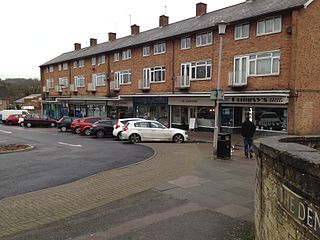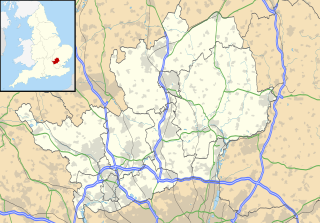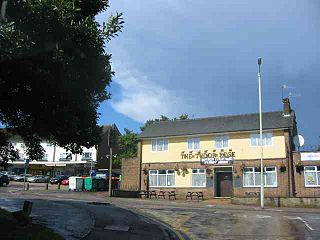
Berkhamsted is a historic market town in Hertfordshire, England, in the Bulbourne valley, 26 miles (42 km) northwest of London. The town is a civil parish with a town council within the borough of Dacorum which is based in the neighbouring large new town of Hemel Hempstead. Berkhamsted and the adjoining village of Northchurch are together encircled by countryside, much of it in the Chiltern Hills, an Area of Outstanding Natural Beauty (AONB).

Hemel Hempstead is a town in Hertfordshire, England, located 24 miles (39 km) northwest of London, and part of the Greater London Urban Area. The population, according to the 2011 Census, was 97,500.

The Borough of Dacorum is a local government district in Hertfordshire, England that includes the towns of Hemel Hempstead, Berkhamsted, Tring and Kings Langley. The district, which was formed in 1974, had a population of 137,799 in 2001. Its name was taken from the old hundred of Dacorum which covered approximately the same area. It is the westernmost of Hertfordshire's districts, being bordered to the west by the Chiltern and Aylesbury Vale districts of Buckinghamshire.

Nash Mills is a civil parish within Hemel Hempstead and Dacorum Borough Council on the northern side of the Grand Union Canal, formerly the River Gade, and in the southernmost corner of Hemel Hempstead. There is evidence of a mill in this location since the 11th century and the row of 16th century mill cottages still remain. John Dickinson established a number of papermaking mills in the area in the 19th century.

Hemel Hempstead is a constituency represented in the House of Commons of the Parliament of the United Kingdom. It elects one Member of Parliament (MP) by the first-past-the-post system of election.

Boxmoor is part of Hemel Hempstead in Hertfordshire. It is within the district of Dacorum and comprises mainly 19th-century housing and meadowland, with transport links from London to the Midlands. At the 2011 Census, the population of Boxmoor was included in the Dacorum ward of Bovingdon, Flaunden and Chipperfield.

Hemel Hempstead Rural District was a rural district in Hertfordshire, England from 1894 to 1974.

The Hemel Hempstead Gazette & Express is a local newspaper in the United Kingdom that covers the towns of Hemel Hempstead, Berkhamsted and Tring and the surrounding area in Hertfordshire.
West Hertfordshire was a parliamentary constituency in Hertfordshire. It returned one Member of Parliament (MP) to the House of Commons of the Parliament of the United Kingdom by the first past the post system. The constituency was abolished for the 1997 general election.

Piccotts End is a village in Hertfordshire, England situated on the upper River Gade. While often mistaken for a hamlet, it became a village when its church – All Saints – was dedicated in 1907 and remained a place of worship until the 1970s. It is in the Dacorum Ward of Gadebridge.

This article gives brief information on schools that cater for pupils up to the age of 11 in the Dacorum district of Hertfordshire, England. Most are county maintained primary schools, sometimes known as "junior mixed infant" (JMI). A small number are voluntary aided church schools or independent (fee-paying). The Local Education Authority is Hertfordshire County Council.
Warners End is a neighbourhood or district of Hemel Hempstead, a new town in Hertfordshire, England. At the 2011 Census the population of the District was included in the Chaulden and Warner's End ward of Dacorum Council. It was the fourth of the new districts built during the expansion of Hemel Hempstead into a new town with work on its construction commencing in 1953.

Dacorum Borough Council is the local authority for the Dacorum non-metropolitan district of England, the United Kingdom. Dacorum is located in the north-west of Hertfordshire, in the East of England region. The Council itself is based in Hemel Hempstead, the largest settlement in the district.

Chaulden is a residential district in Hemel Hempstead, Hertfordshire, England located west of the town centre and bordering on open countryside. It was an early development in the construction of Hemel Hempstead new town, commenced in 1953 and has its own neighbourhood shopping centre.

Peter Anthony Paul Melvin, RIBA, was an English architect. His work over a period of fifty years evolved from large-scale Brutalist projects to small-scale made-to-measure designs. He was a vice-president for education at the Royal Institute of British Architects.

130–136 Piccotts End is a medieval timber framed building in Piccotts End in Hertfordshire, England. Originally a hall house, the structure has been divided into a row of cottages. Two of the cottages are of interest for the art they contain. Important 15th century murals were discovered, at 132, in 1953 and the entire building was listed Grade I the following year. Later murals have been recorded at 134.

Dacorum Heritage (DH) is a local history advocacy group in the United Kingdom. It collects and records the history of the Borough of Dacorum, Hertfordshire, in the south of England, and aims to encourage the appreciation of the heritage of Dacorum.

The Old Town Hall is a municipal building in the High Street, Hemel Hempstead, Hertfordshire, England. The town hall, which was the meeting place of Hemel Hempstead Borough Council, is a Grade II listed building.

Tring Market Hall is a municipal building in the High Street, Tring, Hertfordshire, England. The structure, which is the meeting place of Tring Town Council, is a Grade II listed building.





















